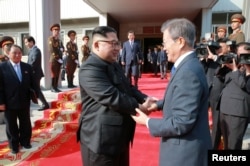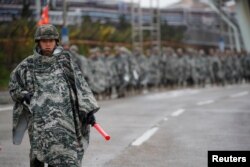The U.S. and South Korea remain united in pursing a diplomatic solution to end the North Korean nuclear threat, but their national security priorities may differ over what would be the role of the U.S. military in Korea after a denuclearization deal is reached.
“That is going to be the moment of truth, so to speak, when the United States and South Korea will have to agree on what kind of security alliance we want to maintain moving forword,” said Go Myong-Hyun, a North Korea analyst at the Asan Institute for Policy Studies in Seoul.
U.S. President Donald Trump on Friday revived the June 12 Singapore summit with North Korean leader Kim Jong Un, eight days after canceling it. Trump said he was convinced of Kim’s commitment to denuclearization by the renewed diplomatic talks that included a visit to Washington by Kim Yong Chol, the North’s former intelligence chief, who carried a letter from the North Korean leader.
South Korean President Moon Jae-in has been influential in facilitating the U.S.-North Korea summit, in getting Kim to agree to the broad goal of denuclearization, and in urging Trump to stay committed to the diplomatic process to resolve differences with North Korea.
President Trump seems to be leaning now towards Moon’s approach versus the more confrontational stance advocated by some of his security team in demanding that North Korea unilaterally and completely disarm before any concessions are granted.
Friday Trump downplayed expectations for a major breakthrough at the summit, saying it will be the beginning of a process. He also backed away from his “maximum pressure” approach that stressed tough sanctions and the threat of military force, focusing instead on brokering an agreement to end the North’s nuclear program for economic aid and security guarantees that could include a peace treaty to replace the armistice that ended the Korean War in 1953.
South Korean officials said there is possibility that Moon may join Trump in Singapore to help negotiate a nuclear deal with Kim, as the South Korean leader shares both Trump’s overall goals, and has developed a positive working relationship with his North Korean counterpart during their two previous summits.
U.S. alliance
However, an effective nuclear deal with Pyongyang could lead to divisions in Seoul and Washington over whether to reduce the U.S. military presence in Korea.
North Korea recently criticized the joint U.S.-South Korea military drills as obstacles to peace in the region and justification of its need for nuclear weapons. U.S. Secretary of Defense Jim Mattis Sunday told reporters that maintaining the current level of over 28,000 American troops in Korea is non-negotiable in the short term.
“One thing that keeps coming up is about our troop strength on the Peninsula. I will say it again, I am not making news here, same thing. They are not going anywhere. It is not even a subject of the discussion,” said Mattis.
The Defense secretary did not rule out reviewing the joint defense posture five to 10 years down the line, if the North Korean threat level decreases.
Trump may be open to withdrawing U.S. troops from the region, as he has criticized South Korea and other countries that host American bases for not paying enough in defense sharing costs. But the U.S. military presence in Korea is also seen as part of a strategic counterbalance to China’s growing military power in the region, and as a way to protect American interests in Asia.
South Korea may not share that same level of support for a strong U.S. military presence in the region, if the Korean Peninsula becomes a nuclear free zone.
“If North Korea completely gives up its nuclear program, a partial reduction in the size of U.S. military presence in South Korea is inevitable. I believe that the size of U.S.-R.O.K. (Republic of Korea) joint military drills should also be reduced,” said Cheong Seong-chang, a North Korea analyst with the Sejong Institute in South Korea.
Moon Chung-in, an adviser to President Moon, said in a recent interview with the Atlantic, that he would like to see the end of the U.S. alliance at some point after the North Korean nuclear threat is resolved, so that South Korea no longer has to take sides between the U.S. and China.
Other security experts such as the Sejong Institute’s Cheong expect the U.S.-South Korea alliance to remain intact, even in a reduced capacity, due to concerns over conflicts with China and Japan, even if the North’s nuclear arsenal is dismantled.
ICBM vs containment
North Korea also poses different types of security threats to Washington and Seoul.
The Trump administration has prioritized preventing North Korea from developing a reliable nuclear-armed intercontinental ballistic missile that could target the U.S. mainland. The U.S. “maximum pressure” policy cited the potential ICBM risk to justify its threat of military action, along with economic sanctions against Pyongyang.
South Korea is more concerned about containing the existing short-range missile, nuclear, and chemical threat, that includes thousands of North Korean artillery stationed along the border. President Moon has pursued increased cooperation projects like reunions for separated families, and military talks at the inter-Korean summits. These trust building measures are intended to create the conditions to negotiate a peace treaty that would likely include limits on conventional forces and weapons systems in the two Koreas.
Lee Yoon-jee in Seoul contributed to this report.









